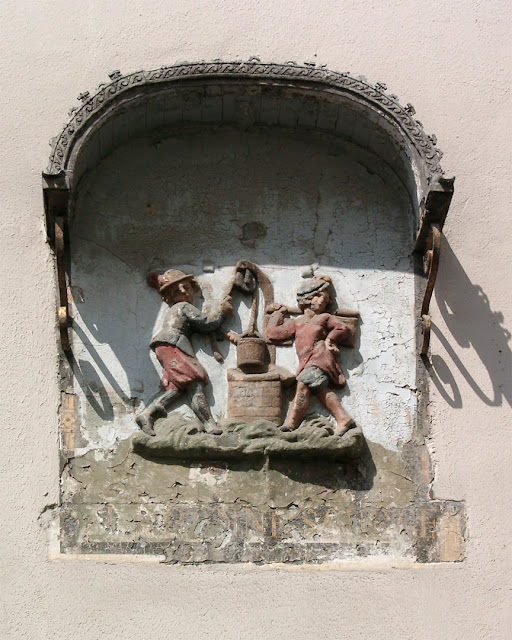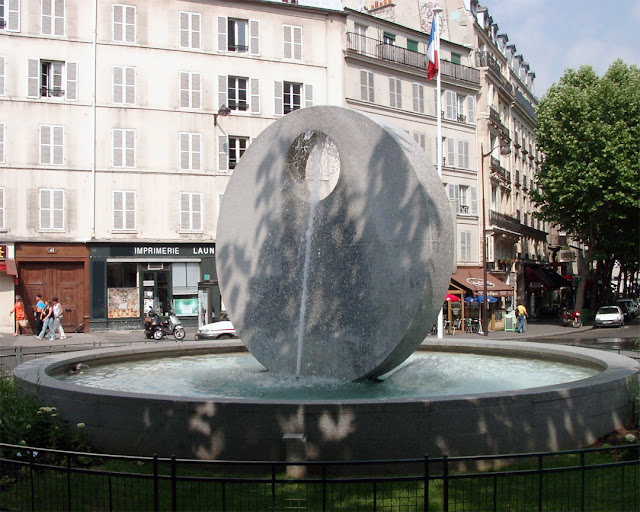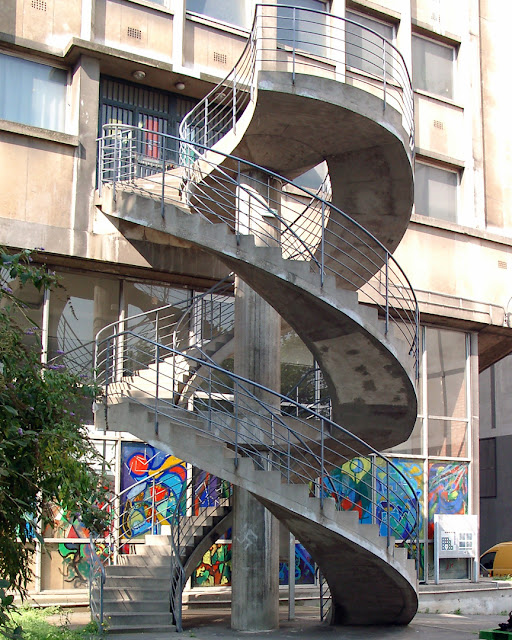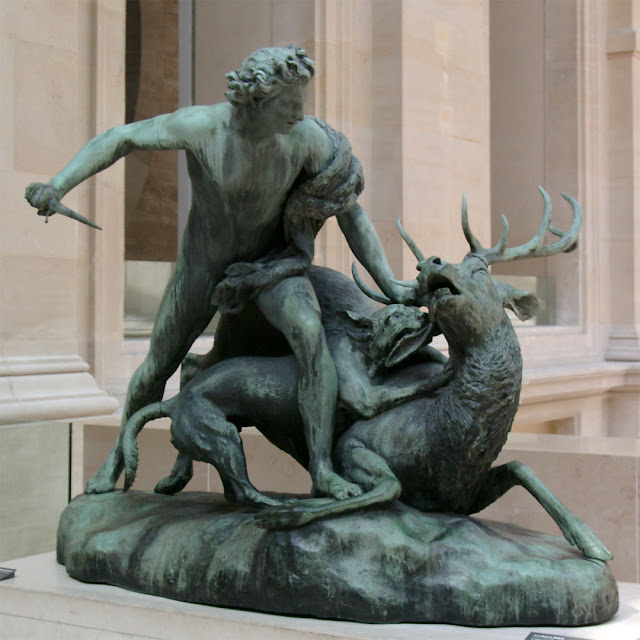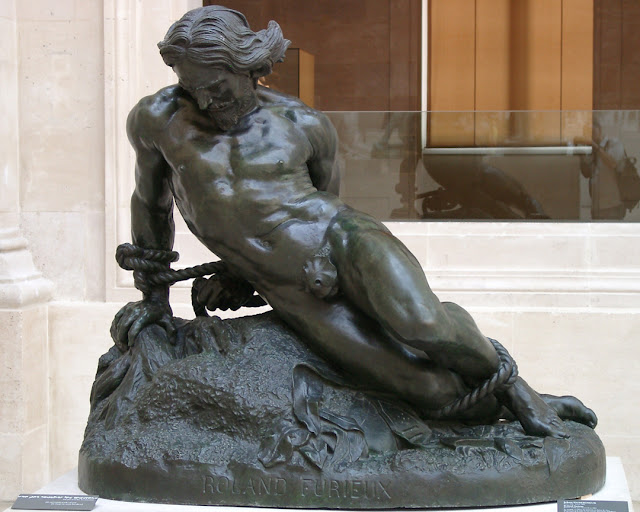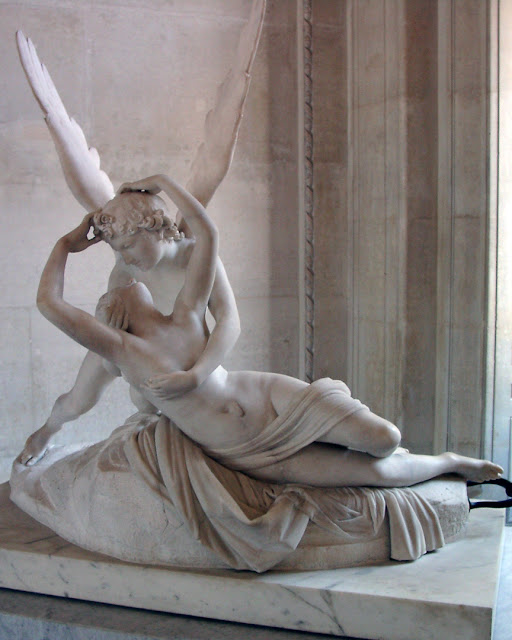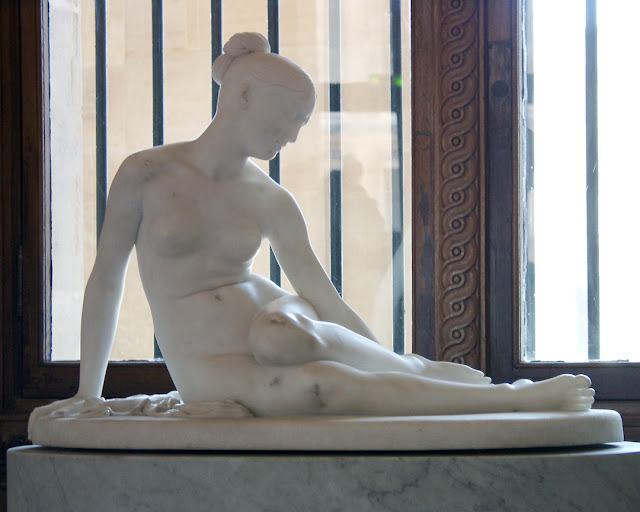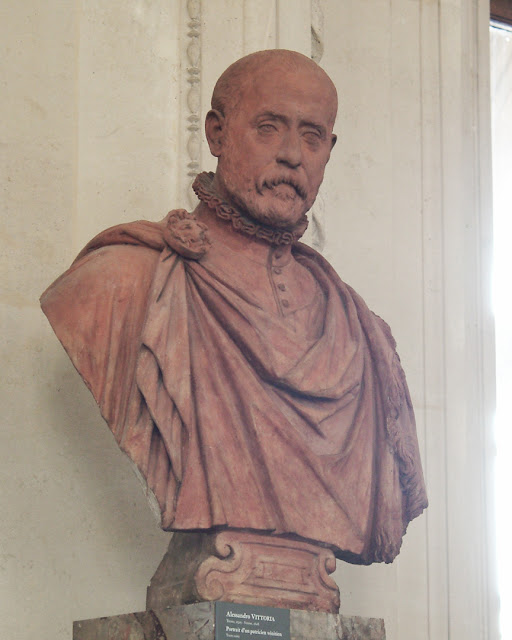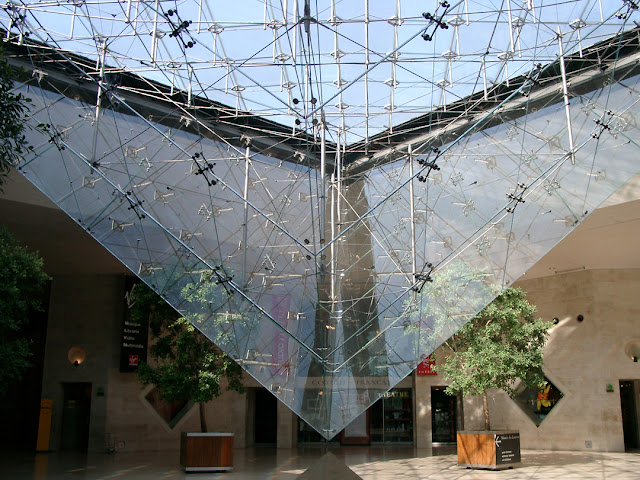Wednesday, May 31, 2006
Tuesday, May 30, 2006
Fontaine Cuvier
Fontaine Cuvier by Alphonse Vigoureux
Rue Linné / Rue Cuvier
Quartier du Jardin-des-Plantes, 5th arrondissement
Paris, July 2005
Monday, May 29, 2006
Sunday, May 28, 2006
Double-helix staircase
Double-helix staircase
Quai Saint-Bernard
Quartier Saint-Victor, 5th arrondissement
Paris, July 2005
Saturday, May 27, 2006
Saint-Cyrille-Saint-Méthode
Église Saint-Cyrille-Saint-Méthode, 1963
Rue de Bagnolet
Quartier de Charonne, 20th arrondissement
Paris, July 2005
Friday, May 26, 2006
Les Mercuriales
Les Mercuriales, 1975
Rue Jean Jaurès
Bagnolet, July 2005
“Les Mercuriales are twin towers in Bagnolet, along the Boulevard Peripherique, in Paris, France. They were built in 1975, and are named Levant (Eastern) and Ponant (Western). These towers were part of a larger project in the business district of eastern Paris, designed to rebalance the western district La Defense. This project was interrupted by the first oil crisis, leaving the isolated towers on the A3 motorway interchange. Not counting the antennas, the towers are the third highest in the Seine-Saint-Denis administrative division, behind Tour Pleyel (143m) and behind the Tour La Villette (125m). Including the antennas, the West Tower is the highest in Seine-Saint-Denis with a peak at about 175m, while the East Tower is the second highest at 141m.” (Les Mercuriales, Wikipedia)
Thursday, May 25, 2006
Château-des-Rentiers
Building by Christian de Portzamparc, 1984
Rue du Château-des-Rentiers
Quartier de la Gare, 13th arrondissement
Paris, July 2005
Wednesday, May 24, 2006
Portrait d'homme
Portrait d'homme de l'époque de l'empereur Gallien
Musée du Louvre
Rue de Rivoli
Quartier Saint-Germain-l'Auxerrois, 1st arrondissement
Paris, July 2005
Tuesday, May 23, 2006
Accueil des groupes
Accueil des groupes, Hall Napoléon
Musée du Louvre
Rue de Rivoli
Quartier Saint-Germain-l'Auxerrois, 1st arrondissement
Paris, July 2005
Monday, May 22, 2006
Sunday, May 21, 2006
Saturday, May 20, 2006
Foreign Legion stall
Foreign Legion stall
Place du Palais-Royal
Quartier du Palais-Royal, 1st arrondissement
Paris, July 2005
Friday, May 19, 2006
Le Génie de la chasse
Le Génie de la chasse by Jean-Baptiste Debay, 1838
Musée du Louvre
Rue de Rivoli
Quartier Saint-Germain-l'Auxerrois, 1st arrondissement
Paris, July 2005
Thursday, May 18, 2006
Lion au serpent
Lion au serpent by Antoine-Louis Barye, 1832
Musée du Louvre
Rue de Rivoli
Quartier Saint-Germain-l'Auxerrois, 1st arrondissement
Paris, July 2005
Wednesday, May 17, 2006
Orlando Furioso
Orlando Furioso by Jean Bernard Duseigneur, 1867
Musée du Louvre
Rue de Rivoli
Quartier Saint-Germain-l'Auxerrois, 1st arrondissement
Paris, July 2005
Tuesday, May 16, 2006
Monday, May 15, 2006
Hercules fighting Acheloos
Hercules fighting Acheloos transformed into a snake by François Joseph Bosio, 1824
Musée du Louvre
Rue de Rivoli
Quartier Saint-Germain-l'Auxerrois, 1st arrondissement
Paris, July 2005
Sunday, May 14, 2006
Napoleon in Triumph
Napoleon in Triumph by François-Frédéric Lemot, 1806
Musée du Louvre
Rue de Rivoli
Quartier Saint-Germain-l'Auxerrois, 1st arrondissement
Paris, July 2005
Saturday, May 13, 2006
Four Captive Nations
Four Captive Nations by Martin Desjardins, 1685
Musée du Louvre
Rue de Rivoli
Quartier Saint-Germain-l'Auxerrois, 1st arrondissement
Paris, July 2005
“His gilt-bronze Four Captive Nations (1682–85) celebrated the early victories of the armies of Louis XIV over the alliances of Spain, the Holy Roman Empire, Brandenburg and the Dutch Republic, in Louis XIV's Place des Victoires, Paris. They ornamented the socle of Desjardins' standing sculpture of Louis XIV, which was melted down at the Revolution. Today the Captifs are conserved in the Louvre, their gilding weathered away. A marble workshop copy of the Louis XIV is to be seen in the Orangerie at Versailles.” (Martin Desjardins, Wikipedia)
Friday, May 12, 2006
Hall Napoléon
Hall Napoléon
Musée du Louvre
Rue de Rivoli
Quartier Saint-Germain-l'Auxerrois, 1st arrondissement
Paris, July 2005
Thursday, May 11, 2006
Rebellious Slave
Rebellious Slave by Michelangelo, 1513
Musée du Louvre
Rue de Rivoli
Quartier Saint-Germain-l'Auxerrois, 1st arrondissement
Paris, July 2005
“The Rebellious Slave is a 2.15m high marble statue by Michelangelo, dated to 1513. It is now held in the Louvre in Paris. The two ‘slaves’ of the Louvre date to the second version of the tomb of Pope Julius II which was commissioned by the Pope's heirs, the Della Rovere in May 1513. Although the initial plans for a gigantic mausoleum were set aside, the work was still monumental, with a corridor richly decorated with sculpture and Michelangelo was immediately put in charge of the work. Among the first pieces completed were the two Prigioni (renamed the ‘slaves’ only in the nineteenth century), destined for the lower part of the funerary monument, next to the pilasters which framed the niches containing the Victories. Their poses were determined by the needs of this architectural setting, so from the front they have great effect, but the side views received less care than usual.” (Rebellious Slave, Wikipedia)
Wednesday, May 10, 2006
Bust of Cardinal Richelieu
Bust of Cardinal Richelieu by Gian Lorenzo Bernini, 1641
Musée du Louvre
Rue de Rivoli
Quartier Saint-Germain-l'Auxerrois, 1st arrondissement
Paris, July 2005
“The Bust of Cardinal Richelieu is a marble sculpture by the Italian sculptor Gian Lorenzo Bernini, situated at the Louvre in Paris. Richelieu had hoped to commission Bernini to make a full-length sculpture, through his friend Jules Mazarin and the French ambassador in Rome François Annibal d'Estrées, but Pope Urban VIII would not permit it, so the sculpture became a bust, sculpted by Bernini between November 1640 and January 1641. He worked from images of Cardinal Richelieu that had been sent to Rome from France. Once completed, the bust was transported to Paris. The bust arrived in Paris in August 1640, but Richelieu was not happy with the work, quickly commissioning another bust by Jean Warin.” (Bust of Cardinal Richelieu, Wikipedia)
Tuesday, May 9, 2006
Psyche Revived by Cupid's Kiss
Psyché ranimée par le baiser de l'Amour (Psyche Revived by Cupid's Kiss) by Antonio Canova, 1793
Musée du Louvre
Rue de Rivoli
Quartier Saint-Germain-l'Auxerrois, 1st arrondissement
Paris, July 2005
“Psyche Revived by Cupid's Kiss (Psyché ranimée par le baiser de l'Amour) is a sculpture by Italian artist Antonio Canova first commissioned in 1787 by Colonel John Campbell. It is regarded as a masterpiece of Neoclassical sculpture, but shows the mythological lovers at a moment of great emotion, characteristic of the emerging movement of Romanticism. It represents the god Cupid in the height of love and tenderness, immediately after awakening the lifeless Psyche with a kiss. The story of Cupid and Psyche is taken from Lucius Apuleius' Latin novel The Golden Ass, and was popular in art. Joachim Murat acquired the first or prime version (pictured) in 1800. After his death the statue entered the Louvre Museum in Paris, France in 1824; Prince Yusupov, a Russian nobleman acquired the 2nd version of the piece from Canova in Rome in 1796, and it later entered the Hermitage Museum in Saint Petersburg. A full-scale model for the 2nd version is in the Metropolitan Museum of Art.” (Psyche Revived by Cupid's Kiss, Wikipedia)
Monday, May 8, 2006
Love and Psyche Standing
L'Amour et Psyché debout (Love and Psyche Standing) by Antonio Canova, 1797
Musée du Louvre
Rue de Rivoli
Quartier Saint-Germain-l'Auxerrois, 1st arrondissement
Paris, July 2005
Sunday, May 7, 2006
Nymph with a Scorpion
La Nymphe au scorpion (Nymph with a Scorpion) by Lorenzo Bartolini, 1845
Musée du Louvre
Rue de Rivoli
Quartier Saint-Germain-l'Auxerrois, 1st arrondissement
Paris, July 2005
Saturday, May 6, 2006
Portrait of a Venetian Patrician
Portrait d'un patricien vénitien (Portrait of a Venetian Patrician) by Alessandro Vittoria, 1575
Musée du Louvre
Rue de Rivoli
Quartier Saint-Germain-l'Auxerrois, 1st arrondissement
Paris, July 2005
Friday, May 5, 2006
Dying Slave
Dying Slave by Michelangelo, 1516
Musée du Louvre
Rue de Rivoli
Quartier Saint-Germain-l'Auxerrois, 1st arrondissement
Paris, July 2005
“The Dying Slave is a sculpture by the Italian Renaissance artist Michelangelo. Created between 1513 and 1516, it was to serve with another figure, the Rebellious Slave, at the tomb of Pope Julius II. It is a marble figure 2.15 metres (7' 4") in height, and is held at the Louvre, Paris. In 1976 the art historian Richard Fly wrote that it ‘suggests that moment when life capitulates before the relentless force of dead matter’. However, in a recent scholarly volume entitled The Slave in European Art, Charles Robertson discusses the Dying Slave in the context of real slavery in Italy during the time of the Renaissance. Fourteen reproductions of the Dying Slave adorn the top storey of the 12th arrondissement police station in Paris. Although Art Deco in style, the building was designed in 1991 by architects Manuel Núñez Yanowsky and Miriam Teitelbaum.” (Dying Slave, Wikipedia)
Thursday, May 4, 2006
Wednesday, May 3, 2006
Safe shipping
Preparing artworks for safe shipping
Musée du Louvre
Rue de Rivoli
Quartier Saint-Germain-l'Auxerrois, 1st arrondissement
Paris, July 2005
Tuesday, May 2, 2006
Pyramide inversée
La Pyramide inversée (The Inverted Pyramid)
Musée du Louvre
Rue de Rivoli
Quartier Saint-Germain-l'Auxerrois, 1st arrondissement
Paris, July 2005
“The Louvre Pyramide inversée (Inverted Pyramid) is a skylight constructed in the Carrousel du Louvre, an underground shopping mall in front of the Louvre Museum in France. It may be thought of as a smaller sibling of the more famous Louvre Pyramid proper, yet turned upside down: its upturned base is easily seen from outside.” (Pyramide inversée, Wikipedia)
Monday, May 1, 2006
The lion and the flags
Lion assis by Auguste Cain, 1884
Right gate of the Eastern façade
Hôtel de Ville
Rue de Lobau
Quartier Saint-Gervais, 4th arrondissement
Paris, July 2005
Subscribe to:
Posts (Atom)

